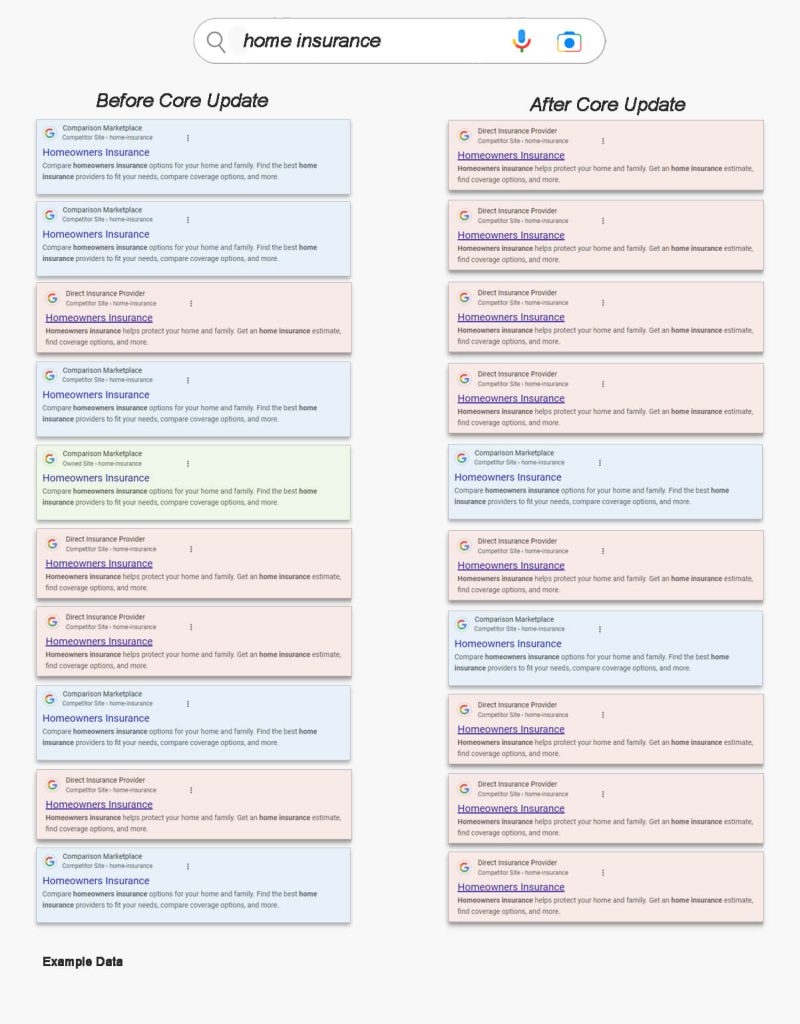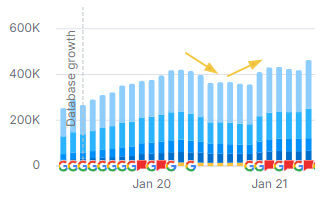+9.2K Top 20 Ranking Keywords
+31.9% in Organic Website Traffic
+96.7% in Transactional “Comparison” Traffic
*Data in this case study consists of real numbers from third party analytics platforms. For privacy reasons, we do not disclose the brand name in this case study.
The Problem
Our insurance marketplace client faced a sudden and severe drop in organic search performance following the May 2020 Google core update. This update shifted search engine results for many high-value keywords to favor direct provider brands over comparison sites, leading to a significant decline in traffic and revenue from highly transactional keywords.
With their business heavily reliant on organic traffic, this posed a critical challenge to their revenue stream and overall online presence.
TechAudits Strategic Approach
Recognizing the urgency of the situation, we began by thoroughly analyzing the core update’s impact on our client’s site and the broader competitive landscape. Collaborating closely with the client’s teams, we prioritized immediate actions to stabilize traffic, such as optimizing certain content, solidifying technical SEO elements, and refining key transactional pages.
Simultaneously, we developed a long-term strategy focused on diversifying revenue sources and adapting to the evolving SERP landscape, ensuring both immediate recovery and sustained growth.
The Results
Through our targeted efforts, we successfully reversed the downward trend, achieving a complete recovery and even surpassing previous traffic and revenue levels.
Not only did we regain lost ground on key comparison terms, but we also strengthened the site’s overall performance, securing top rankings for critical keywords and expanding into new, profitable areas.
Our work resulted in a significant increase in organic traffic and revenue, setting the client on a path to continued success despite the evolving search landscape.
Partnership Details
Brand + Awareness
This partnership focused primarily on the Awareness portion of the TechAudits offering, with the goal of expanding brand visibility and conversions in key categories. The Brand component became more of a priority later in the partnership after the higher priority growth-focused items were implemented. We employed a mix of tactics within technical SEO, content strategy, and user experience to combat the impact of this Google update and simultaneously expand brand reach in other areas.
Implementations
- Robust content strategy, focusing on diversifying revenue-driving traffic sources and expanding reach
- Essential technical SEO fixes such as internal linking structure, sitemap optimization, and crawlability
- Strategically segmented analytics and monitoring for key areas
- Enhanced page elements for high value URLs
- E-E-A-T focused efforts such as schema markup, review solicitation and visibility on CTA pages, and brand listing consistency
Let TechAudits help your brand navigate core updates and difficult search landscapes.
Get started with managed SEO services today.
The Story
A significant shift in the types of results that search engines display for certain keywords can have a dramatic impact on a website’s performance. We worked with an insurance marketplace brand that helped users navigate through insurance options and compare cost and options that dealt with this.
They relied heavily on Google organic traffic to drive revenue. For quite some time they were able to position themselves in top ranking positions for highly transactional queries with massive MSV (monthly search volume). But after the May 2020 core update, these SERPs shifted overnight to favor direct provider brands over comparison sites and marketplaces, tanking the revenue driven by the organic channel.

before and after a core update for a query, not depicting actual search results.
Our Immediate Response
As expected, the alarms went off on our client’s side and we needed to come together to find a solution ASAP. We know we can’t control what search intent Google is showing directly. However, thankfully we established a thorough understanding of the brand and knew their strengths, allowing us to quickly craft a short- and long-term recovery strategy.
We started with a summary of the core update, its purpose, and its initial impact on our client’s site and their competitors to understand what we were up against. We joined this understanding with our previous brand discovery materials to create a sort of SWOT analysis to guide us in navigating the impact of these changes.
From there, we collaborated with various client teams including performance marketing, content, and developers to get an updated view into resourcing and capabilities. Equipped with the necessary context and knowledge, we were able to reprioritize and adjust our strategy to stop the bleeding and achieve a speedy recovery without it being at the expense of future growth.
Short-term key initiatives:
- Lean into comparison content and rankings where our brand perfectly matched search intent
- Reprioritize our strategy roadmap to focus primarily on the most impacted and high revenue website categories
- Increase priority of technical website fixes to maximize link value flow and page performance
- Fine tune page elements on still-performing key transactional content
Planning for Long-term key initiatives:
- Conduct an in-depth competitor, audience/intent, and SERP landscape analysis
- Revise landing pages targeting broad transactional queries with intent in mind
- Grow other areas of the website in organic performance to diversify revenue sources and mitigate risk
- Solicit more reviews, bolster EEAT signals, and other brand reputation efforts
Analysis
Having proper data collection systems in place proved invaluable during this time, as it allowed us to rapidly pivot and begin investigating the performance. The data we analyzed included:
- Rankings segmented by topic cluster
- Website traffic trends and click-through-rates (CTR)
- Conversion funnel flow data (engagement, user behavior, and ultimately form fills)
- Competitor ranking movement
- SERP landscape changes
- and more
The trends and correlations within this data was able to provide great insights as to how we should respond to this shift. We were able to see that the new top ranking results for queries we’ve declined in were favoring direct insurance providers. Conversely, the rankings we’ve held steady in or improved were in topic spaces around comparison or exploring options. This was evident in all metrics and collected information, showing a clear picture of what these changes were. Additionally, we were able to identify a few conversion bottlenecks that were specific to certain site sections or topic clusters.

As you can see in the chart above, the May core algorithm update was the starting point for significant organic traffic declines following a long period of consistent growth. These declines persisted over the following months while we worked through our recovery strategy. Then, we saw immediate recovery in the December core algorithm update. Sometimes it takes a core update for a “reset” of sorts to fully realize the impact of the improvements you’ve been making to the site. This was evident in this example, considering the SERP intent issues we were facing did not revert or change much with the December update. The results favoring direct insurance providers remained, while our organic traffic made more than a full recovery.
Strategic Shifts
Coming out of our analysis, we were able to make a few key strategic shifts. While we were narrowly focused on the organic search channel, we were able to also play a consulting role with strategic moves in their other marketing efforts such as paid search and email marketing.
Much of our strategy going into this turbulent period remained, as it was aimed to boost the authority, reach, and performance of the site as a whole. However, reprioritizing and redistributing limited resources was a necessary action. Here are a few key ways that we chose to pivot.
Double Down on Our Place in the Market
As search engines become more and more advanced in their ability to surface relevant options for users’ searches, the ability for a single brand to “do it all” becomes increasingly more difficult. This was evident in our performance metrics following this core update. The first response in our content strategy was to use this to our advantage and put more emphasis into perfecting the content that was well aligned with the client’s offering – to compare and guide insurance buyers to their best option.
Solidify Foundational Tech SEO
In our partnership up to the point of this core update, we had struggled with implementing a few key technical SEO items. This included enhancements to the XML sitemap and internal linking structure. As recovering organic performance became more urgent, we were able to revisit these updates and get them pushed through quickly to ensure content was discovered and indexed by search engines and to maximize the link value flow throughout the site.
Adapt Our Approach to Performance & Landscape Monitoring
We believe strongly in data-backed decision making. With new factors coming into play, we revisited our performance and website monitoring practice to collaborate on improvements. This resulted in some simple yet impactful changes that yielded valuable insights to guide us and validate or challenge our strategic shifts as they were made.
Controlling the Narrative with Page Revisions
Although we determined that we may not see the performance previously experienced from pages targeting the more broad transactional terms as the client experienced in the past, we were all aligned that these pages were still crucial to the business and user experience on the website. This content still undoubtedly had conversion value – both direct and indirect through lead nurturing as seen through multi-touch attribution reporting.
Bolster E-E-A-T Signals and Trust Building
Focus on user trust and building authority is always a core part of our strategy and building brand reputation for our clients. To work towards this we focused on authorship, data source citations, highlighting company reviews, and building authoritative backlinks and social proof from partnerships with other reputable brands.
Measurement
While adjusting our strategy and implementing any more immediate items to address these declines, we ensured our performance measurement systems were in place to gauge the impact and track our recovery.
This shift in the type of sites ranking for our priority keywords was the main contributor to some substantial declines over the first 6 months.

We dropped in rank for 35 of our priority transactional terms (910K in MSV) including keywords like these falling from top 5 positions all the way down to page 2 or 3:
- “insurance quote”
- “home insurance estimate”
- “get an insurance quote”
Our efforts were able to more than fully recover traffic and revenue. In addition to recovery in the affected areas, we were able to grow revenue in comparison terms like these (comparing previous and ending ranks):
- home insurance comparison: 16 > 1
- compare house insurance: 17 > 3
- compare home insurance quotes: 17 > 4
- compare homeowners insurance: 10 > 2
| Metric | Initial Impact | Recovery |
|---|---|---|
| Top 20 Ranking Keywords | -19.9% | +8.3% |
| Organic Website Traffic | – 25.9% | +31.90% |
Moving Forward
The changes in search intent did fluctuate in the months following this update, allowing us to pop in and out of rankings for the broad transactional terms. However, the majority of our priority terms continued to be largely dominated by direct providers. This is evidence of Google’s advancement of understanding intent and refining results to match what users are seeking.
By leaning into this and doubling down on queries our client’s product offering was well suited for, we successfully recovered revenue, diversified performing portions of the website, and proactively planned to avoid future risks.